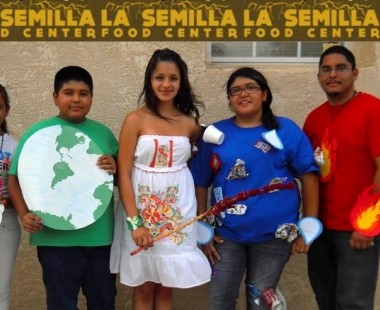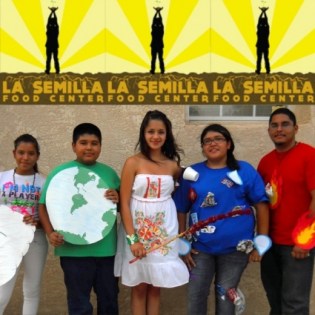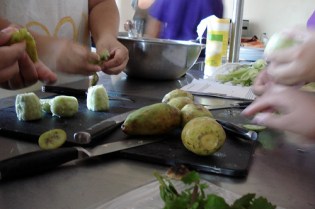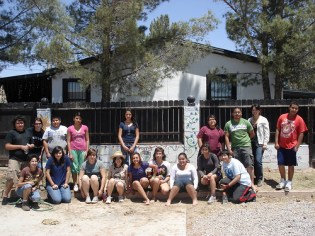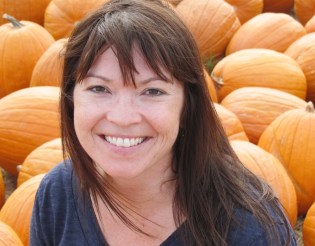
Rebecca Wiggins-Reinhard.
Those who live in the desert borderlands of southern New Mexico face plenty of serious struggles. Water is limited, living wages are scarce, and many live in unincorporated communities called colonias, which often lack basic infrastructure like roads and gas lines. Things are so tough there, in fact, that one might understandably presume that the only food issue on residents’ minds is whether or not they’ll have enough. Not so, argues Rebecca Wiggins-Reinhard, director of the Farm Fresh program for La Semilla Food Center in Las Cruces, the largest city south of Albuquerque. In 2010, Wiggins and two colleagues founded Semilla (“Seed” in Spanish), with plans to start a youth food policy council, a youth farm, and multiple produce stands. After their inaugural year, which included the council’s launch and the gift of 15 acres to start the farm, Wiggins’ work won her an Institute for Agriculture and Trade Policy (IATP) fellowship — and a visit from cookbook author, New York Times columnist, and food maven Mark Bittman. I spoke with Wiggins by phone to hear about her surprising path to food work, her plan to grow 500 foods in a desert, and what it’s like to promote local food in the country’s fifth-poorest state.
Q. You didn’t start out as a food person. How did you end up doing work that lured Mark Bittman to the desert?
A. [Before La Semilla] I was a grad student in political science, and I have a history of being involved in human rights movements on the border. I was working at Colonias Development Center, and I came in after a USDA Community food projects grant was [going] to start community gardens, and I realized I had a passion for working with youth and growing food. [Before that], if you’d asked me about food, I probably would have said, What’s the big deal, you go to the grocery store and you buy it. Once I saw that [only some] eaters have access to food and income to buy healthy food, how that’s a human rights issue, it was a natural fit for me. It was, How did I miss this?
Q. Colonias are known for lacking things like roads and water lines. What does that mean for food?
A. There are very small grocery stores and little corner stores, but they don’t always have the healthiest or the freshest food available and that’s really part of our work — to pilot market stands in the community to increase access to that fresh food. There’s no organic food, there’s very little choice. Most of these colonias are in very rural areas, and you have to have a car or know someone who can give you a ride. We did a [community food] survey with our youth in 2009, and everyone said they go to Las Cruces or El Paso [to buy groceries]; it’s 20-30 miles, and there’s no public transportation. People prefer to have healthier choices and more options, so they’ll drive elsewhere.
Q. A small town in Maine just passed a food sovereignty law, and there are a number of U.S. organizations beginning to talk about that idea, which is the belief that having access to healthy food and retaining control of its production is an essential human right. How does food sovereignty factor in to your work?
A. I have a lot of experience with communities in Chiapas, Mexico, where I worked with a weaving cooperative. The reason they have to sell their products is they are no longer able to farm their land for subsistence. We should be able to grow enough food for our own subsistence if we choose to, and use our land the way we want without having powerful corporations make choices for us. I think food sovereignty is also tied to being able to save seeds that are GMO- and chemical-free, and having more choices that aren’t determined by corporations.
I think our work is entirely in line with [food sovereignty]. We will be growing desert foods and things you can’t find in the grocery store [at the youth farm], like amaranth. Right now, much of what’s grown in New Mexico is shipped out, and we can really grow our local economy if we sell our food here instead of selling to an outside company.
Q. Desert farming? Could you really feed a modern community on that?
A. In southern New Mexico, we have a year-round growing season. It’s pecan, cotton, alfalfa for most of it, [and] you can grow so much here with modest season extension techniques; there are 550 varieties of fruits and vegetables that can grow here. The problem in the desert is water [and] our farm is also meant to show that we can use dry land farming techniques.
Q. New Mexico is one of the poorest states in the country. How can farmers markets make sense for a population where the median household income is 16 percent below the national average?
A. I think farmers market prices here are quite affordable and many of the vendors take WIC [Women, Infants and Children support service] checks. Some of the colonia communities have really high redemption rates for WIC checks there, and it’s a great way to access fresh food. They are also usually getting food grown without pesticides and people want those choices. One thing in our area that we are lacking is the use of EBT (food stamp cards). There’s only one market in our region that accepts EBT and part of my work is trying to increase access to EBT at markets.
Q. What’s been the biggest barrier to seeing your students change their eating behaviors?
A. I think any personal behavior change is hard … [and] it needs to be a family effort, not just an individual one. [In our cooking classes] we found that that was more effective in making change within a household because parents are largely responsible for the purchasing decisions. So we’re focusing our efforts on more activities with family, and I think our classes will feature recipes anyone can do with minimal cooking experience. For the most part people were looking for ways to incorporate healthy cooking and that’s why they joined the program. We had no one here who said, “I’m never going to stop eating McDonald’s.” But we did have one who said, “I’m not eating at McDonald’s any more.”

